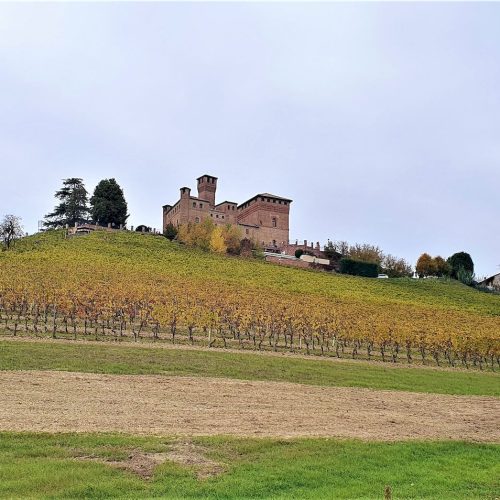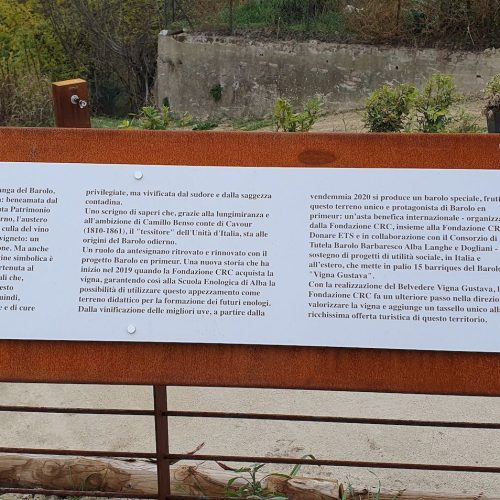The castle of Grinzane Cavour is a symbol of the Langhe’s history.
An imposing, majestic castle that connects Alba, the capital of the Langhe, to the territory of the Barolo vineyards: we are talking about Grinzane Cavour Castle. This splendid fortress is located just a stone’s throw from the city of Alba and is one of the historical symbols of the Langhe.
Grinzane Cavour Castle, built in the 12th century, was the residence of the Cavour family from 1832 to 1967. Today, it houses the Museum of Peasant Civilizations of the Langhe and Roero and the prestigious Enoteca Regionale del Barolo.
Anyone visiting the Langhe should make an almost obligatory stop at Grinzane Cavour Castle. The rooms inside preserve much of the period’s original furnishings, especially those of the Library and the Dining Room. In addition, the museum allows visitors to discover the life of the ancient farmers through objects, tools, and machinery used for working the fields and making wine.
But the real treasure of Grinzane Cavour Castle is the Enoteca Regionale del Barolo. This exceptional wine cellar houses about 600 Barolo labels from all over the Langhe region. Here, you can taste the famous Piedmontese red wine, which is defined as one of the kings of wines, accompanied by local gastronomy products.
Grinzane Cavour Castle’s beauty is magnified by its privileged position on the top of a hill surrounded by vineyards and woods. The panoramic view is breathtaking and allows one to appreciate the beauty of the Langhe’s nature.

Grinzane Cavour Castle: History
The castle was built in the 12th century. It was the summer residence of the Marquis of Busca until 1832, when it was sold to Count Camillo Benso di Cavour, famous for being one of the fathers of the Unification of Italy.
The castle’s beginnings date back to the 11th century, when the territory was disputed between the powerful Marquises of Saluzzo and the bishops of Asti. In 1164, the Marquises of Saluzzo ceded the fiefdom to the bishops of Asti, but as early as the 13th century, they were forced to reconquer it and build a fortress to defend themselves against enemy raids.
Later, over the centuries, the castle of Grinzane Cavour underwent numerous transformations and extensions. In the 15th century, it was donated to the Marquises of Busca, who transformed it into a stately residence with Italian gardens, fountains, and rose gardens. In 1832, Count Camillo Benso di Cavour bought the castle and made it his summer residence.
But the castle’s history is not limited to the vicissitudes of its owners. Over time, numerous noble marriages have occurred, such as between Charles Emmanuel I of Savoy and Catherine Micaela of Austria in 1585 or between Charles Albert of Savoia and Maria Theresa of Tuscany in 1831.
The castle of Grinzane Cavour is also associated with some legacies that have marked the history of Italy. In 1854, after Count Cavour’s death, his sister, Adelaide, inherited the castle and donated it to the Municipality of Grinzane Cavour. Today, the castle houses the Museum of Wine and Peasant Civilization of the Langhe, where the history of viticulture and local agriculture is told.

Grinzane Cavour: 100 years since the Italian Unification, a necessary restoration
On the occasion of the first centenary of the birth of the Italian state, it was decided to take over the castle and restore it to its former splendor. The year is 1961.
Architect Andrea Bruno said:
“The restoration was not meant to be limited to repairing the damage of time and preserving the monument by restoring its lost integrity but also had, as an indispensable purpose, a new destination that would revive it by prolonging its life over time.”
The result is very satisfactory. Exterior structures and tenements that had sprung up in the vicinity were demolished, freeing up the imposing silhouette that can be seen today. It also leaves open views of the surrounding hills.

Camillo Benso Count of Cavour
The history of this statesman and his long periods of stay in the Castle merge with the years that led to the success and transformation of the Barolo area.
We do not want to focus on his political figure, which is well known and studied. Instead, we want to discuss his relationship with the Castle of Grinzane Cavour, his favorite home for many years.
Cavour loved spending time in the hills of Barolo, where he devoted himself to viticulture and producing fine wine. For him, the Castle represented a place of tranquility and inspiration.
But in addition to being a private residence, Grinzane Cavour Castle also played an important role in Italy’s history. The deal between the Kingdom of Sardinia and Napoleon III, which led to Italian unification, was signed here.
But how does Camillo Benso come to take possession of the cCastle Let’s start a few years earlier, we are in 1815: Camillo’s aunt, Duchess Vittoria de Sellon, buys a plot of land in Grinzane: 180 hectares in all, and along with the plot is included the ownership of one of the medieval cCastle Camilla’s aunt, however, does not feel up to the task of administering a property like that, so she asks Michele Benso, her brother-in-law and Camillo’s father, if he would like to rent the set of land and cCastle Done deal in the family!
Michele and his son Camillo: From father to son.
Michele Benso decided to allow his son Camillo to grow and gain experience, giving him the very management of this part of the Langhe.
Camillo moves in and gains appreciation and esteem. In September 1832, at twenty-two, he became mayor of Grinzane.
His arrival in Grinzane is joyous for both the town and the Castle. Camillo devoted himself to changing both the Castle and the surrounding estates. He became passionate about tending the vineyards, which would become a real challenge for him.
Cavour will be mayor of Grinzane for a full 17 years. While mayor, he was also involved in higher-level politics, eventually becoming prime minister of the Kingdom of Savoia and one of the originators of the Unification of Italy.
The Castle is his favorite residence: when you visit it you can still see his bedroom with much of its original furniture.

The educational vineyard
The aim was to merge the Castle with the surrounding vineyards by creating an open-air, barrier-free route. The educational vineyard, a real attraction for wine enthusiasts, made this possible.
The educational vineyard at Grinzane Cavour Castle allows visitors to discover the world of viticulture in an interactive and engaging way. Thanks to information panels, visitors can learn about the stages of wine production, from harvesting to winemaking and up to bottling.
After understanding the stages of winemaking, all that will remain is an inevitable and desired tasting.
The educational vineyard at Grinzane Cavour Castle is open all year round and is suitable for all visitors, both the curious and those with some knowledge. Moreover, the vineyard’s panoramic location allows visitors to enjoy one of the most beautiful landscapes of the Langhe, where the hills slope gently toward the horizon.
With a visit to the Castle, you will understand the product that is so widespread and loved in the Langhe: wine in all its forms.

Visiting the castle: what to expect
Grinzane Cavour Castle is one of Italy’s most famous castles. Located in the hills of Piedmont, it was built for defensive purposes.
A visit to Grinzane Cavour Castle will allow you to discover the history of the Piedmontese nobility and the Cavour family and appreciate the region’s artistic and cultural heritage. You can admire the original furnishings of the period, the rooms decorated with frescoes, and the many works of art on display inside the castle.
In particular, I suggest you linger in the Ballroom, where you can imagine parties and receptions of the Piedmontese nobility. And where you can think of political arrangements of extraordinary magnitude! The wonderful frescoes depict scenes of daily life of the time.
As I mentioned earlier, after visiting Grinzane Cavour Castle, you can complete your knowledge with a tasty and fragrant tasting of local wines.
If you are a culinary enthusiast, you may also have the opportunity to visit the Museum of Peasant Civilization, where you can discover the local culinary tradition and its evolution over the centuries.
The castle is part of many of our Langhe Tours, the gateway to the Barolo area.
When to visit the castle? How to reach it?
When you decide to visit the castle, it is essential to know that most of its attractions are open year-round, except during the Christmas holidays. If you want to enjoy the mild spring or summer weather, I recommend that you consider these seasons to enjoy the surrounding landscape as well.
There are several options available for reaching the castle. If you are a lover of adventure and sports, you can consider cycling to the castle. We have thought of many bike tours with routes that will allow you to easily reach the castle by bicycle.
If you do not like cycling but prefer walking, you could go on a Trekking Langhe around the castle. We have mapped out many hiking trails that have the castle as their focus and/or destination.
Finally, if you want a more romantic and unique experience, you might consider a Vespa Tour. You’ll enjoy a panoramic ride through the hills of Barolo before reaching the Castle of Grinzane Cavour itself.
Either way, once you arrive at the castle, you will be fascinated by the beauty and majesty of this historic building. You can admire the panoramic view of the surrounding countryside, visit the wine museum, and taste some of the region’s best wines.


Comments